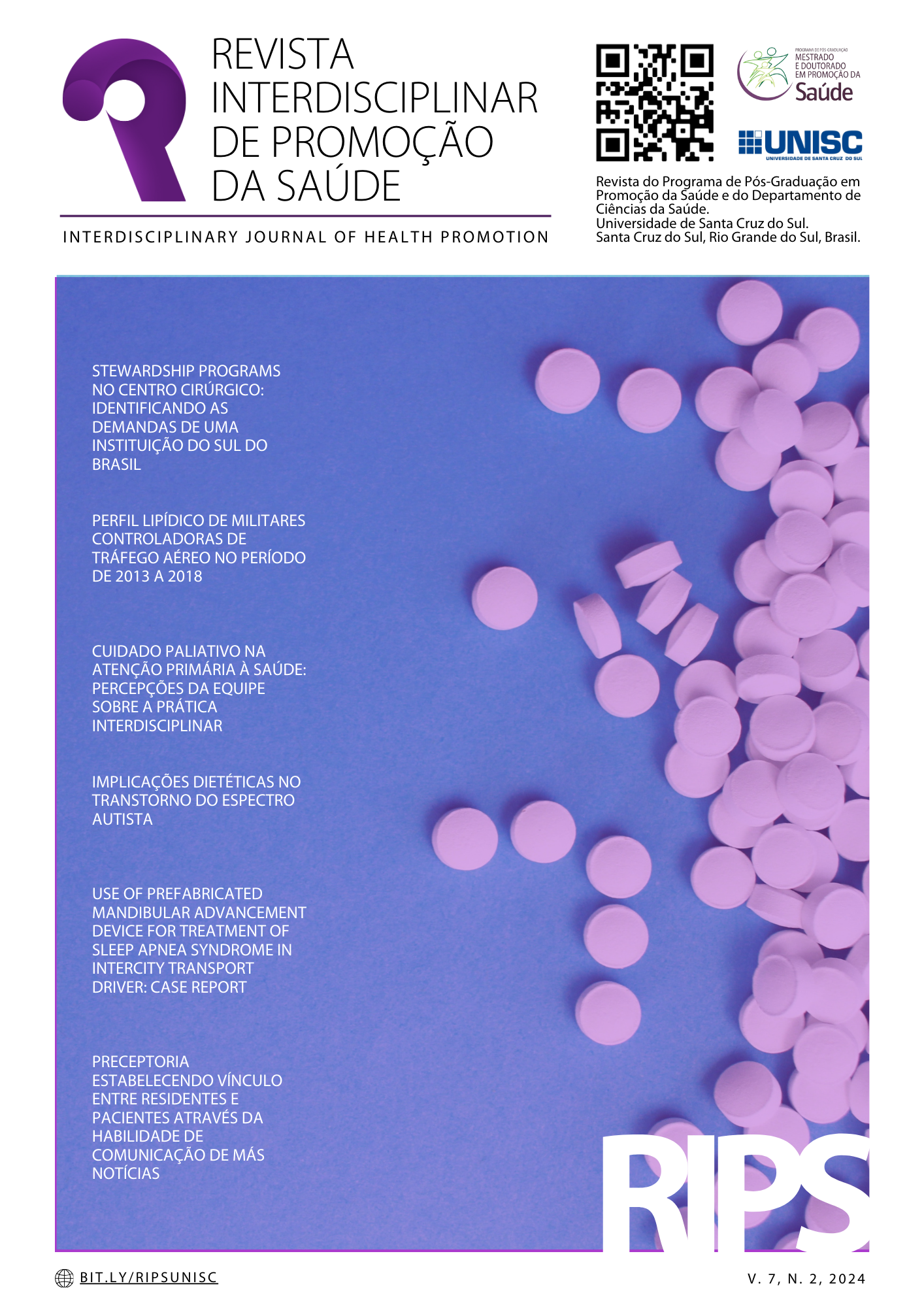USE OF PREFABRICATED MANDIBULAR ADVANCEMENT DEVICE FOR TREATMENT OF SLEEP APNEA SYNDROME IN INTERCITY TRANSPORT DRIVER: CASE REPORT
DOI:
https://doi.org/10.17058/rips.v7i2.18557Keywords:
Obstructive sleep apnea, Quality of life, Sleepiness, Dental researchAbstract
ABSTRACT
Introduction: In obstructive sleep apnea syndrome (OSAS) there are obstructions in the upper airway that cause desaturations, sleep disorders and an increased risk of involvement in car accidents due to poor sleep quality. The Mandibular Advancement Device (MAD) is one of the therapeutic alternatives for this syndrome. Objective: To evaluate the effects of MAD in an intercity public transport driver with OSAS. Methods: This is a case report of an individual submitted to MAD for a period of eight weeks. The Epworth Sleepiness Scale, the Apnea-Hypopnea Index (AHI) were evaluated using the polysomnographic profile and the quality of life (QoL) using the SF-36 questionnaire. The severity of OSAS was defined by the (AHI in which ≥ 5 and ≤ 15 are classified as mild; moderate when ≥ 15 and < 29; and AHI ≥ 30, severe). Results: There was a reduction in the AHI from moderate to normal (16.0 → 1.8 ev/h), a reduction in the Epworth Sleepiness Scale (5 → 3), an increase in the domains of the QOL questionnaire in the domains of functional capacity (65 → 90), physical limitations (75 → 100), general condition (30 → 35), vitality (50 → 55), emotional aspects (33.33 → 100) and mental health (52 → 76). Conclusion: There was a reduction in the apnea and hypopnea index and sleepiness and increase in quality of life after using a mandibular advancement device in an intercity public transport driver.
Keywords: Sleep Apnea, Obstructive; Quality of life; Sleepiness; Dental Research.
Downloads
References
Karhu T, Myllymaa S, Nikkonen S, Mazzotti DR, Kulkas A, Töyräs J, et al. Diabetes and cardiovascular diseases are associated with the worsening of intermittent hypoxaemia. Journal of Sleep Research. 2021;31(1):e13441. doi: https://doi.org/10.1111/jsr.13441
Bahammam AS, Alkhunizam MA, Lesloum RH, Alshanqiti AM, Aldakhil AM, Pandi-perumal SR, Sharif MM. Prevalence of sleep-related accidents among drivers in Saudi Arabia. Ann Thorac Med. 2014;9(4):236-41. doi: https://doi.org/10.4103/1817-1737.140138
Benoist L, de Ruiter M, de Lange J, de Vries N. A randomized, controlled trial of positional therapy versus oral appliance therapy for position-dependent sleep apnea. Sleep Med. 2017;34(1):109-17. doi: https://doi.org/10.1016/j.sleep.2017.01.024
Bertolazi AN, Fagondes SC, Hoff LS, Pedro VD, Barreto SSM. Validação da escala de sonolência de Epworth em português para uso no Brasil. J Bras Pneumol. 2009;35(9):877-83. doi: https://doi.org/10.1590/S1806-37132009000900009
Ciconelli RM, Ferraz MB, Santos W, Meinão I, Quaresma MR. Tradução para a língua portuguesa e validação do questionário genérico de avaliação de qualidade de vida SF-36 (Brasil SF-36). Rev Bras Reumatol. 1999;39(1):143-50.
Parthasarathy S, Zhang J, Hyman D, Doherty J, Saad R, Fox B, et al. Comorbidities and presenting symptoms in a real-world population with obstructive sleep apnea. CNS Spectrums. 2023;28(2):230-231. doi: https://doi.org/10.1017/S1092852923001554
Vries GE, Hoekema A, Vermeulen KM, Claessen JQPJ, Jacobs W, Maten J, Hoeven JH, Stegenga B, Kertjens HAM, Wijkstra PJ. Clinical and cost-effectiveness of a mandibular advancement device versus continuous positive airway pressure in moderate obstructive sleep apnea. J Clin Sleep Med. 2019;15(10):1477-85. doi: https://doi.org/10.5664/jcsm.7980
Dieltjens M, Vanderveken O. Oral appliances in obstructive sleep apnea. Healthcare. 2019;7(4):1-12. doi: https://doi.org/10.3390/healthcare7040141
Feltner C, Wallace IF, Aymes S, Middleton JC, Hicks KL, Schwimmer M, Baker C, Balio CP, Moore D, Voisin CE, Jonas DE. Screening for obstructive sleep apnea in adults: updated evidence report and systematic review for the US preventive services task force. JAMA. 2022;328(19):1951-71. doi: https://doi.org/10.1001/jama.2022.18357
Gottlieb DJ, Punjabi NM. Diagnosis and management of obstructive sleep apnea: a review. JAMA. 2020;323(14):1389-400. doi: https://doi.org/10.1001/jama.2020.3514
World Health Organization (WHO). Physical status: the use and interpretation of anthropometry. Report of a WHO Expert Committee. World Health Organization Technical Report Series. 1995;854:1-452.
Haddad FLM, Vidigal TA, Mello-Fujita L. The influence of nasal abnormalities in adherence to continuous positive airway pressure device therapy in obstructive sleep apnea patients. Sleep Breath. 2013;17(4):1201-07. doi: https://doi.org/10.1007/s11325-013-0824-5
Ibrahimi ME, Laabouri M. Pilot study of a new adjustable thermoplastic mandibular advancement device for the management of obstructive sleep apnoea-hypopnoea syndrome: a brief research letter. Open Respir Med J. 2016;10(1):46-59. doi: https://doi.org/10.2174%2F1874306401610010046
Chaves Junior CM, Dal-Fabbro C, Bruin VMS, Tufik S, Bittencourt LRA. Consenso brasileiro de ronco e apneia do sono – aspectos de interesse aos ortodontistas. Dental Press J Orthod. 2011;16(1):1-10 doi: https://doi.org/10.1590/S2176-94512011000100007
Putra DGAE, Wiranadha M, Winata FY, Kusuma IBGH. Correlation between type 2 diabetes mellitus with the risk of obstructive sleep apnea in Prof. Dr. I.G.N.G. Ngoerah Hospital Denpasar. Eur J Clin Med. 2023;4(4):13-17. doi: https://doi.org/10.24018/clinicmed.2023.4.4.277
Karkoulias K, Lykouras D, Sampsonas F, Karaivazoglou K, Sargianou M, Drakatos P, Spiropoulos K, Assimakopoulos K. The impact of obstructive sleep apnea syndrome severity on physical performance and mental health. The use of SF-36 questionnaire in sleep apnea. Eur Rev Med Pharmacol Sci. 2013;17(1):531-36.
Kostrzewa-Janicka J, Śliwiński P, Wojda M, Rolski D, Mierzwińska-Nastalska E. Mandibular advancement appliance for obstructive sleep apnea treatment. Adv Exp Med Biol. 2017;944(1):63-71. doi: https://doi.org/10.1007/5584_2016_61
May JF, Porter BE, Ware C. The deterioration of driving performance over time in drivers with untreated sleep apnea. Accid Anal Prev. 2016;89(1):95-102. doi: https://doi.org/10.1016/j.aap.2016.01.002
Oksenberg A, Goizman V, Eitan E, Nasser K, Dagoth N, Leppänen T. Obstructive sleep apnea: do positional patients become nonpositional patients with time? Laryngoscope. 2020;130(9):2263-68. doi: https://doi.org/10.1002/lary.28387
Schwartz M, Acosta L, Hung YL, Padilla M, Enciso R. Effects of CPAP and mandibular advancement device treatment in obstructive sleep apnea patients: a systematic review and meta-analysis. Sleep Breath. 2018;22(3):1-14. doi: https://doi.org/10.1007/s11325-017-1590-6
Downloads
Published
How to Cite
Issue
Section
License
A submissão de originais para este periódico implica na transferência, pelos autores, dos direitos de publicação impressa e digital. Os direitos autorais para os artigos publicados são do autor, com direitos do periódico sobre a primeira publicação. Os autores somente poderão utilizar os mesmos resultados em outras publicações indicando claramente este periódico como o meio da publicação original. Em virtude de sermos um periódico de acesso aberto, permite-se o uso gratuito dos artigos em aplicações educacionais e científicas desde que citada a fonte conforme a licença CC-BY da Creative Commons.



